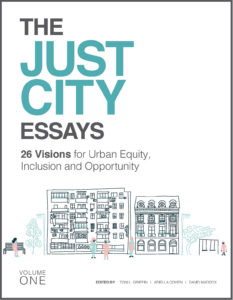“Five years ago, the Harvard Graduate School of Design’s Just City Lab published The Just City Essays: 26 Visions of Inclusion, Equity and Opportunity. The questions it posed were deceptively simple: What would a just city look like? And what could be the strategies to get there? These questions were posed to mayors, architects, artists, philanthropists, educators and journalists in 22 cities, who told stories of global injustice and their dreams for reparative and restorative justice in the city.
 These essays were meant as a provocation, a call to action. Now, during these times of dissonance, unrest, and uncertainty, their contents have become ever more important. For the next 26 weeks [starting June 15, 2020], the GSD and the Just City Lab will republish one essay a week here and at designforthejustcity.org. We hope they may continue conversations of our shared responsibility for the just city.
These essays were meant as a provocation, a call to action. Now, during these times of dissonance, unrest, and uncertainty, their contents have become ever more important. For the next 26 weeks [starting June 15, 2020], the GSD and the Just City Lab will republish one essay a week here and at designforthejustcity.org. We hope they may continue conversations of our shared responsibility for the just city.
We believe design can repair injustice. We believe design must restore justice, especially that produced by its own hand. We believe in justice for Black Americans. We believe in justice for all marginalized people. We believe in a Just City.”
—Toni L. Griffin, Professor in Practice of Urban Planning, founder of the Just City Lab, and editor of The Just City Essays
Creating Universal Goals for Universal Growth
By Betsy Hodges
There is a difference between equality and equity. Equality says that everybody can participate in our success and equity says we need to make sure that everybody actually does participate in our success and in our growth. A just city is a city free from both inequity and inequality.
We pay a significant price for inequities—in the billions in our cities, in the trillions nationwide. Growth is commonly pointed to as a solution, but growth for the sake of growth alone cannot solve these inequalities and inequities. However, solving these inequalities and inequities gets us growth.
Inequities make our cities risky business ventures. We don’t have the workforce that we need because we are not getting everyone into the workforce; we don’t have the consumer base that we need because not everyone can afford to consume. It creates an atmosphere where people are hesitant to invest because they don’t know if they’re going to have the consumer base or the workforce base that they need.
My city of Minneapolis suffers from some of the largest racial disparities in America on almost any measure: employment, housing, health, education, incarceration—the list goes on. For example, while 67 percent of white kids graduate on time from Minneapolis Public Schools, only 37 percent of African-American and Latino kids do, and just 22 percent of American-Indian kids. When you consider that in just a few years, a majority of Minneapolis’ population will be people of color, this disparity is economically unsustainable, in addition to being morally wrong.
Minneapolis is in the midst of a building boom; cranes dot the sky as far as the eye can see. But growth alone can’t solve our equity problem. It’s not turning Minneapolis into a just city, because our current growth doesn’t include everybody. Even though our overall unemployment rate has declined, the gap between white people and people of color remains the same.
The moral of this story is that if your boat is leaky or you don’t have one to begin with, the rising tide can’t and won’t lift you.
In our just city we must accept that inclusive growth is a better strategy than growth alone. Inclusive growth means that your life outcome is not determined by your race, age, gender, or zip code. Inclusive growth means we aren’t leaving any genius on the table. To achieve this, we need two things: universal shared goals about what we want for ourselves as a people and as a community, and the policies that will ensure that people get there. Continue reading on designforthejustcity.org…
